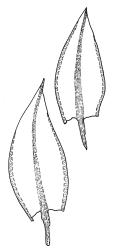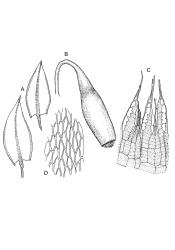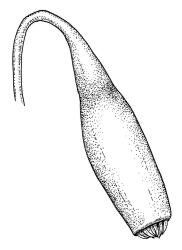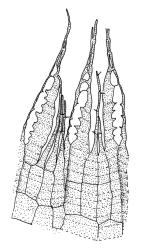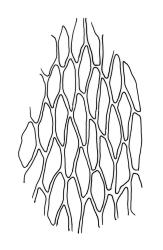- ≡ Ptychostomum creberrimum (Taylor) J.R.Spence & H.P.Ramsay in Spence, Phytologia 87: 23 (2005)
- = Bryum austropallescens Broth., Öfvers. Finska Vetensk.-Soc. Förh. 40: 178 (1898) – as austro-pallescens
B. affine sensuSainsbury (1955), pro parte
Plants yellow-green, forming rather dense turves. Stems red, to at least 23 mm, branching repeatedly by innovation, beset below with brown, papillose rhizoids, in cross-section with a distinct central strand. Leaves evenly spaced on sterile stems and innovations, larger and ± crowded at tips of male branches, erect-spreading when moist, spiralled around the stem when dry, ovate-lanceolate (widest below mid leaf), abruptly tapered to an acute apex, c. 1.3–2.3 mm long (excluding perichaetial) and with the lamina ≥0.9 the total leaf length, moderately concave, with red pigments restricted to costa, entire, bordered, and recurved at margins, not decurrent; upper laminal cells rhombic-hexagonal, firm-walled, not or weakly porose, c. 40–65 µm long and c. 4–5:1, scarcely differentiated near apex, more oblong but not larger in lower leaf; marginal cells distinctly or weakly differentiated, usually forming a well-defined border c. 3–5 cells wide at mid leaf and extending to apex; basal cells not pigmented. Costa stout (c. 60 µm wide at mid leaf), red at base, excurrent to form a short or elongate and denticulate awn (sometimes percurrent in smaller leaves). Brood bodies (including tubers) absent.
Autoicous (with unisexual perichaetia and terminal perigonia) or less commonly polygamous. Perichaetia basal, often 2 or more on one plant, overtopped by innovations, sometimes with a few intermixed antheridia in N.Z. material; perichaetial leaves more narrowly lanceolate and with more excurrent costa than vegetative leaves. Perigonia terminal on innovative branches, with bracts ± comal and more spreading than adjacent leaves, enclosing numerous antheridia and filiform paraphyses. Setae mostly 25–35 mm, red, cygneous just below the capsule; capsules pendent, 2.5–3 mm, oblong-cylindric, narrowed below mouth when dry, with a well-defined neck c. ⅓ the total length; operculum low-conic and apiculate. Exostome teeth pale brown; endostome with broadly perforate segments separated by groups of 3 mostly appendiculate cilia. Spores 10–18(–24) µm, nearly smooth.
Catcheside 1980, fig. 149; Demaret 1986, fig. 2.
Bryum creberrimum in N.Z. is most readily recognizable by its ovate-lanceolate, entire leaves with firm-walled laminal cells, which are non-comose and twisted spirally around the stem when dry. The endostome has appendiculate cilia, usually in 3s (sometimes in 2s or with some cilia nodose). Most of the material is autoicous (i.e., with unisexual perichaetia at or near the plant base, and unisexual perigonia at the apex of elongate innovations), as is the sexuality of the lectotype.
The spirally twisted dry leaves of B. creberrimum invite confusion with Rosulabryum capillare. Bryum creberrimum has vegetative leaves that are widest below the middle (± ovate-lanceolate), with firmer-walled and wider laminal cells, and stouter, less strongly excurrent costae. No rhizoidal tubers have been seen and the sexuality is ± consistently autoicous. By comparison, R. capillare has ± spathulate leaves with thinner-walled and generally narrower laminal cells, narrower and long-excurrent costae, and conspicuous rhizoidal tubers. Most N.Z. R. capillare is synoicous.
SI: Canterbury (Broad Stream, Mt Cook Range), Otago (Kinloch, Pine Hill, Naseby).
Bipolar? The species boundaries and consequently the distribution of this species are poorly understood. Spence & Ramsay (2006, p. 326, as Ptychostomum creberrimum) record it from Tasmania and several mainland Australian states and indicate it to be "a pantemperate species in both hemispheres".
The habitat preferences of this species are poorly known in N.Z.; several collections from Naseby are from c. 610 m. Catcheside (1980, p. 260) indicates this species grows on basic substrates in South Australia.
In N.Z. B. creberrimum and its ally B. pallescens are both variable and poorly represented in herbaria. Bryum creberrimum is here treated to include material with a considerable range of spore size. The Western Australian type collection has smaller spores, more excurrent costae, and less distinct leaf borders than most N.Z. populations. The lack of correlation between sexuality and spore size characters makes some N.Z. material difficult to name confidently.
Intermediate material occurs from, e.g., Mt Owen, Nelson L.D. (A.J. Fife 5103, CHR 185996 and J.K. Bartlett 22532, CHR 350050) and near Homer Tunnel, Southland L.D. (W. Martin 924, CHR 579237). These collections have some or all plants synoicous, and relatively large (c. 3 mm) oblong-cylindric capsules. The Homer Tunnel collection was recorded by Sainsbury (1955, p. 271) as B. affine (Bruch) Lindb., but no purpose is served by recognizing yet another "species" allied to this intergrading and confusing species pair.
The confusion surrounding B. creberrimum, and the several taxa that have been confused with it in Australasia, was discussed nearly a century ago by Dixon (1926, p. 207). Sainsbury (1955) appears to have followed Dixon; he treated the material considered here to be B. creberrimum and B. pallescens as B. austropallescens Broth. and B. affine (Bruch) Lindb., respectively. The detail of the relationship between B. creberrimum and its close allies remains poorly understood in N.Z., and in other regions where it occurs.
Ochi (1970, p. 48) considered B. creberrimum Taylor to be a synonym of what he termed B. capillare, and this was followed by Fife (1995), while Syed (1973, p. 318) seems to have been the first to propose that B. creberrimum Taylor is the earliest name for a widespread species known "by the illegitimate name B. affine Lindb." Examination of the lectotype of B. creberrimum in the Taylor herbarium confirms that it is not R. capillare. Whether B. creberrimum, based on an Australian type, is conspecific with northern hemisphere material of "B. affine Lindb." is a problem requiring monographic study and is beyond the scope of this Flora.



